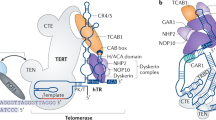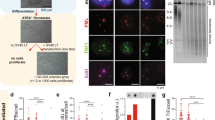Abstract
The telomerase reverse transcriptase component (TERT) is not expressed in most primary somatic human cells and tissues, but is upregulated in the majority of immortalized cell lines and tumors. Here, we identify the c-Myc transcription factor as a direct mediator of telomerase activation in primary human fibroblasts through its ability to specifically induce TERT gene expression. Through the use of a hormone inducible form of c-Myc (c-Myc-ER), we demonstrate that Myc-induced activation of the hTERT promoter requires an evolutionarily conserved E-box and that c-Myc-ER-induced accumulation of hTERT mRNA takes place in the absence of de novo protein synthesis. These findings demonstrate that the TERT gene is a direct transcriptional target of c-Myc. Since telomerase activation frequently correlates with immortalization and telomerase functions to stabilize telomers in cycling cells, we tested whether Myc-induced activation of TERT gene expression represents an important mechanism through which c-Myc acts to immortalize cells. Employing the rat embryo fibroblast cooperation assay, we show that TERT is unable to substitute for c-Myc in the transformation of primary rodent fibroblasts, suggesting that the transforming activities of Myc extend beyond its ability to activate TERT gene expression and hence telomerase activity.
This is a preview of subscription content, access via your institution
Access options
Subscribe to this journal
Receive 50 print issues and online access
$259.00 per year
only $5.18 per issue
Buy this article
- Purchase on Springer Link
- Instant access to full article PDF
Prices may be subject to local taxes which are calculated during checkout






Similar content being viewed by others
References
Bello-Fernandez C, Packham G and Cleveland JL. . 1993 Proc. Natl. Acad. Sci. USA 90: 7804–7808.
Bishop JM, Eilers M, Katzen AL, Kornberg T, Ramsay G and Schirm S. . 1991 C.S.H. Symp. Quant. Biol. 56: 99–107.
Bodnar AG, Kim NW, Effros RB and Chiu CP. . 1996 Expt. Cell Res. 228: 58–64.
Bodnar AG, Ouellette M, Frolkis M, Holt SE, Chiu CP, Morin GB, Harley CB, Shay JW, Lichtsteiner S and Wright WE. . 1998 Science 279: 349–352.
Counter CM, Avilion AA, LeFeuvre CE, Stewart NG, Greider CW, Harley CB and Bacchetti S. . 1992 EMBO J. 11: 1921–1929.
Dmitrovsky E, Kuehl WM, Hollis GF, Kirsch IR, Bender TP and Segal S. . 1986 Nature 322: 748–750.
Eilers M, Picard D, Yamamoto KR and Bishop JM. . 1989 Nature 340: 66–68.
Eilers M, Schirm S and Bishop JM. . 1991 EMBO J. 10: 133–141.
Fujimoto K and Takahashi M. . 1997 Biochem. Biophys. Res. Comm. 241: 775–781.
Galaktionov K, Chen X and Beach D. . 1996 Nature 382: 511–517.
Grandori C, Mac J, Siebelt F, Ayer DE and Eisenman RN. . 1996 EMBO J. 15: 4344–4357.
Grandori C and Eisenman RN. . 1997 TIBS 22: 177–181.
Greenberg R, Allsopp RC, Chin L, Morin GB and DePinho RA. . 1998 Oncogene 16: 1723–1730.
Harley CB, Futcher AB and Greider CW. . 1990 Nature 345: 458–460.
Harrington L, Zhou W, McPhail T, Oulton R, Yeung DS, Mar V, Bass MB and Robinson MO. . 1997 Genes Dev. 11: 3109–3115.
Hastie ND, Dempster M, Dunlop MG, Thompson AM, Green DK and Allshire RC. . 1990 Nature 346: 866–868.
Hiyama E, Hiyama K, Yokoyama T, Matsuura Y, Piatyszek MA and Shay JW. . 1995 Nature Med. 1: 249–255.
Kilian A, Bowtell DD, Abud HE, Hime GR, Venter DJ, Keese PK, Duncan EL, Reddel RR and Jefferson RA. . 1997 Hum. Mol. Genet. 6: 2011–2019.
Kim NW, Piatyszek MA, Prowse KR, Harley CB, West MD, Ho PL, Coviello GM, Wright WE, Weinrich SL and Shay JW. . 1994 Science 266: 2011–2015.
Kiyono T, Foster SA, Koop JI, McDougall JK, Galloway DA and Klingelhutz AJ. . 1998 Nature 396: 84–88.
Klingelhutz AJ, Foster SA and McDougall JK. . 1996 Nature 380: 79–82.
Lachman HM and Skoultchi AI. . 1984 Nature 310: 592–594.
Land H, Parada LF and Weinberg RA. . 1983 Nature 304: 596–602.
Lee TC, Li L, Philipson L and Ziff EB. . 1997 Proc. Natl. Acad. Sci. USA 94: 12886–12891.
Littlewood TD, Hancock DC, Danielian PS, Parker MG and Evan GI. . 1995 Nuc. Acids Res. 23: 1686–1690.
Marhin WW, Chen S, Facchini LM, Fornace Jr AJ and Penn LZ. . 1997 Oncogene 14: 2825–2834.
Meyerson M, Counter CM, Eaton EN, Ellisen LW, Steiner P, Caddle SD, Ziaugra L, Beijersbergen RL, Davidoff MJ, Liu Q, Bacchetti S, Haber DA and Weinberg RA. . 1997 Cell 90: 785–795.
Nakamura TM, Morin GB, Chapman KB, Weinrich SL, Andrews WH, Lingner J, Harley CB and Cech TR. . 1997 Science 277: 955–959.
Nakayama J, Tahara H, Tahara E, Saito M, Ito K, Nakamura H, Nakanishi T, Tahara E, Ide T and Ishikawa F. . 1998 Nature Genet. 18: 65–68.
Reed JC, Alpers JD, Nowell PC and Hoover RG. . 1986 Proc. Natl. Acad. Sci. USA 83: 3982–3986.
Schreiber-Agus N, Chin L, Chen K, Torres R, Rao G, Guida P, Skoultchi AI and DePinho RA. . 1995 Cell 80: 777–786.
Serrano M, Lin AW, McCurrach ME, Beach D and Lowe SW. . 1997 Cell 88: 593–602.
Smith S, Giriat I, Schmitt A and de Lange T. . 1998 Science 282: 1484–1487.
van Steensel B and de Lange T. . 1997 Nature 385: 740–743.
Vaziri H and Benchimol S. . 1998 Curr. Biol. 8: 279–282.
Wagner AJ, Meyers C, Laimins LA and Hay N. . 1993 Cell Growth Differ. 4: 879–883.
Wang J, Xie LY, Allan S, Beach D and Hannon GJ. . 1998 Genes Dev. 12: 1769–1774.
Wright WE and Shay JW. . 1995 Trends Cell Biol. 5: 293–297.
Xu HJ, Zhou Y, Ji W, Perng GS, Kruzelock R, Kong CT, Bast RC, Mills GB, Li J and Hu SX. . 1997 Oncogene 15: 2589–2596.
Acknowledgements
We would like to thank Arthur Skoultchi for providing MEL and Myc56MEL cells, Scott Lowe for the mouse ecotropic receptor and the pBABE-RASG12V plasmids, Nicole Schreiber-Agus for critical review of the manuscript, Tin Hoang and Michael Lombardi for technical support, and Joel Bolonick for bioinformatics assistance. RAG is supported by NIH Training Grant 5T32GM07491. RAD is supported by grants (R01HD28317, R01EY09300, R01EY11267) from the National Institutes of Health, an AHA Grant-in-AID. RAD is a recipient of the Irma T Hirschl Award and an American Cancer Society Research Professor.
Author information
Authors and Affiliations
Rights and permissions
About this article
Cite this article
Greenberg, R., O'Hagan, R., Deng, H. et al. Telomerase reverse transcriptase gene is a direct target of c-Myc but is not functionally equivalent in cellular transformation. Oncogene 18, 1219–1226 (1999). https://doi.org/10.1038/sj.onc.1202669
Received:
Revised:
Accepted:
Published:
Issue Date:
DOI: https://doi.org/10.1038/sj.onc.1202669
Keywords
This article is cited by
-
NIPSNAP1 directs dual mechanisms to restrain senescence in cancer cells
Journal of Translational Medicine (2023)
-
Integrated analysis of telomerase enzymatic activity unravels an association with cancer stemness and proliferation
Nature Communications (2021)
-
Regulation of human telomerase in homeostasis and disease
Nature Reviews Molecular Cell Biology (2020)
-
TERT promotor region rearrangements analyzed in high-risk neuroblastomas by FISH method and whole genome sequencing
International Journal of Clinical Oncology (2020)
-
Aloe emodin inhibits telomerase activity in breast cancer cells: transcriptional and enzymological mechanism
Pharmacological Reports (2020)



